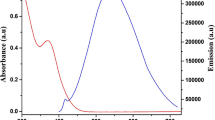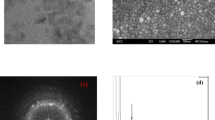Abstract
The interaction of 2,2-diphenyl-1-picrylhydrazyl (DPPH●) free radical with thiol-capped CdTe quantum dots (QDs) has been studied by UV–vis spectroscopy, steady state and time resolved fluorescence measurements. Addition of DPPH● radical to CdTe QDs resulted in fluorescence quenching. The interaction occurs through static quenching as this was confirmed by fluorescence lifetime measurements. Time course absorption studies indicates that DPPH● may be reduced by interaction with QDs to the substituted hydrazine form (2,2-diphenyl-1-picrylhydrazine) DPPH-H. The mechanism of fluorescence quenching of CdTe QDs by DPPH● is proposed.







Similar content being viewed by others
References
Yun-Sheng X, Chang-Qing Z (2009) Interaction of CdTe nanocrystals with thiol-containing amino acids at different pH: a fluorimetric study. Microchim Acta 164:29–34
Ming H, Jia N (2010) Determination of vanadium (V) with CdTe quantum dots as fluorescent probes. Anal Bioanal Chem 397:3589–3593
Ling D, Zhou PJ, Li SQ, Shi GY, Zhong T, Wu M (2011) Spectroscopic studies on the thermodynamic of L-cysteine capped CdSe/CdS quantum dots-BSA interaction. J Fluoresc 21:17–24
Fan J, Zhou J, Sun T, Lu S, Tang J, Lu J (2010) Multi-spectroscopic study on the interaction between CdTe quantum dots and bovine serum albumin. Chin J Chem 28:2353–2358
Juan-Juan P, Shao-Pu L, Lei W, You-Qiu H (2010) Studying the interaction between CdTe quantum dots and nile blue by absorption, fluorescence and resonance rayleigh scattering spectra. Spectrochimica Part A 75:1571–1576
Raquel EG, Miguel-De-La G (2009) The use of quantum dots in organic chemistry. Trends Anal Chem 28:279–291
Ken-Tye Y, Wing-Cheung L, Indrajit R, Zhu J, Huijie H, Mark TS, Paras NP (2011) Aqueous phase synthesis of CdTe quantum dots for biophotonics. J Biophotonics 4:9–20
Xianxiang W, Yi L, Xiandeng H (2011) A potential visual fluorescence probe for ultratrace arsenic (III) detection by using glutathione-capped CdTe quantum dots. Talanta 84:382–386
Victor IK (2010) Nancrystal quantum dots. CRC, Florida
Mulder WJM, Koole R, Brandwijk RJ, Storm G, Chin PTK, Strijkers GJ, De-Donega C, Nicolay K, Griffioen AW (2006) Quantum dots with a paramagnetic coating as a bimodal molecular imaging probe. Nano Lett 6:1–6
Jin WJ, Fernandez-Arguelles MT, Costa-Fernandez JM, Pereiro R, Sanz-Medel A (2005) Photoactivated luminescent CdSe quantum dots as sensitive cyanide probes in aqueous soultions. Chem Commun 883–885
Tomasulo M, Yildiz I, Raymo FM (2006) pH-sensitive quantum dots. J Phys Chem B 110:3853–3855
Ping Z, Ying Y, Jianzhong W, Yan L, Bo C, Zhaoyang L, Chunsui L (2006) Preparation and application of functionalized nanoparticles of CdSe capped with 11-mercaptoundecanoic acid as a fluorescent probe. Talanta 70:902–906
Qiao X, Jian-Hao W, Zhan W, Zhao-Hui Y, Qin Y, Yuan-Di Z (2008) Interaction of CdTe quantum dots with DNA. Electrochem Commun 10:1337–1339
Callen JF, Mulrooney RC, Sukanta K, Bridgeen M (2008) Anion sensing with luminescent quantum dots – a modular approach based on the photoinduced electron transfer (PET) mechanism. J Fluoresc 18:527–532
Neuman D, Ostrowski AD, Mikhailovsky AA, Absalonson RO, Strouse GF, Ford PC (2008) Quantum dot fluoresence quenching pathways with Cr (III) complexes. Photosensitized NO Production from trans-Cr(cyclam)(ONO) +2 . J Am Chem Soc 130:168–175
Jin T, Fujii F, Yamada E, Nodasaka Y, Kinjo M (2007) Preparation and characterization of thiacalix[4]arene coated water-soluble CdSe/ZnS quantum dots as a fluorescent probe for Cu2+ ions. Comb Chem High Throughput Screening 10:473–479
Vincent M, Marie L, Paul B, Robert G, Scaiano JC (2006) Free radical sensor based on CdSe quantum dots with added 4-Amino-2,2,6,6-Tetramethylpiperidine oxide functionality. J Phys Chem B 110:16353–16358
Jie FS, Cui LR, Li HL, Xing GC (2008) CdTe quantum dots as fluorescence sensor for the determination of vitamin B6 in aqueous solution. Chin Chem Lett 19:855–859
Wenfeng Z, Yingsing F, Waisum O, Cheung MPL (2010) L-cysteine-capped CdTe quantum dots as fluoresencence probe for determination of cardiolipin. Anal Sci 26:879–884
Ionita P (2005) Is DPPH stable free radical a good scavenger for oxygen active species? Chem Pap 59:11–16
Fery-Forgues S, Lavabre D (1999) Are fluorescence quantum yields so tricky to measure? A demonstration using familiar stationery products. J Chem Ed 76:1260–1264
Lakowicz JR (1999) Principles of fluorescence spectroscopy. Plenum, New York
Hao Z, Zhen Z, Bai Y (2003) The influence of carboxyl groups on the photoluminescence of mercaptocarboxylic acid-stabilized CdTe nanoparticle. J Phys Chem B 107:8–13
Idowu M, Chen J-Y, Nyokong T (2008) Photoinduced energy transfer between water-soluble CdTe quantum dots and aluminium tetrasulfonated phthalocyanine. New J Chem 32:290–296
Yu WW, Qu L, Guo W, Peng X (2003) Experimental determination of the extinction coefficient of CdTe, CdSe, and CdS nanocrystals. Chem Mater 15:2854–2860
Guo W, Li JJ, Wang YA, Peng X (2003) Luminescent CdSe/CdS core/shell nanocrystals in dendron boxes: superior chemical, photochemical and thermal stability. J Am Chem Soc 125:3901–3909
Jipei Y, Weiwei G, Erkang W (2008) Investigation of some critical parameters of buffer conditions for the development of quantum dots-based optical sensors. Anal Chim Acta 630:174–180
Duyang G, Zonghai S, Heyou H (2010) A novel method for the analysis of calf thymus DNA based on CdTe quantum dots-Ru(bpy) 2+3 photoinduced electron transfer system. Microchim Acta 168:341–345
Mandal A, Tamai N (2008) Influence of acid on luminescence properties of thioglygolic acid-capped CdTe quantum dots. J Phys Chem C 112:8244–8250
Blatt E, Mau AWH, Sasse WHF, Sawyer WH (2008) Simulated Stern-Volmer Plots for 1–1 Ground-State Complexation. Aust J Chem 41:127–131
Jhonsi MA, Renganathan R (2010) Investigation on the photoinduced interaction of water soluble thioglycolic acid (TGA) capped CdTe quantum dots with certain porphyrins. J Colloid Interface Sci 344:596–602
Wang X, Qu L, Zhang J, Peng X, Xiao M (2003) Surface-related emission in highly luminescent CdSe quantum dots. Nano Lett 3:1103–1106
Sanz M, Correa-Duarte MA, Liz-Marzan LM, Douhal A (2008) Femtosecond dynamics of CdTe quantum dots in water. J Photochem Photobiol A: Chem 196:51
Chong EZ, Matthews DR, Summers HD, Njoh KL, Errington RJ, SmithPJ (2007) Development of fret-based assays in the far-red using CdTe quantum dots. J Biomed Biotechnol 54169
Javier A, Magana D, Jennings T, Strouse GF (2003) Nanosecond exciton recombination dynamics in colloidal CdSe quantum dots under ambient conditions. Appl Phys Lett 83:1423–1425
Zhang JY, Wang XY, Xiao M (2002) Modification of spontaneous emission of CdSe/CDS quantum dots in the presence of a semiconductor interface. Opt Lett 27:1253–1255
Geckeler KE, Samal S (2001) Rapid assessment of the free radical scavenging property of fullerenes. Fullerene Sci Technol 9:17–23
Paul S, Saikia JP, Samdarshi SK, Konwar BK (2009) Investigation of antioxidant property of iron oxide particles by 1,1-diphenylpicryl-hydrazyle (DPPH) method. J Magn Magn Mater 321:3621–3623
Ryoko I, Tomokazu Y, Kunio E (2005) Preparation of Au/TiO2 nanocomposites and their catalytic activity for DPPH radical scavenging reaction. J Colloid Interface Sci 288:177–183
Demirhan F, Taban G, Baya M, Dinoi C, Daran J-C, Poli R (2006) Reduction of [Cp *2 Mo2O5]by thioglycolic acid in an aqueous medium: Synthesis and structure of [{Cp*Mo(μ-SCH2COO)}2(μ-S)]. J Organomet Chem 691:648–654
Acknowledgements
This work was supported by the Department of Science and Technology (DST) and National Research Foundation (NRF), South Africa through DST/NRF South African Research Chairs Initiative for Professor of Medicinal Chemistry and Nanotechnology as well as Rhodes University and DST/Mintek Nanotechnology Innovation Centre (NIC) – Sensors, South Africa.
Author information
Authors and Affiliations
Corresponding author
Rights and permissions
About this article
Cite this article
Adegoke, O., Chidawanyika, W. & Nyokong, T. Interaction of CdTe Quantum Dots with 2,2-Diphenyl-1-Picrylhydrazyl Free Radical: A Spectroscopic, Fluorimetric and Kinetic Study. J Fluoresc 22, 771–778 (2012). https://doi.org/10.1007/s10895-011-1012-2
Received:
Accepted:
Published:
Issue Date:
DOI: https://doi.org/10.1007/s10895-011-1012-2




